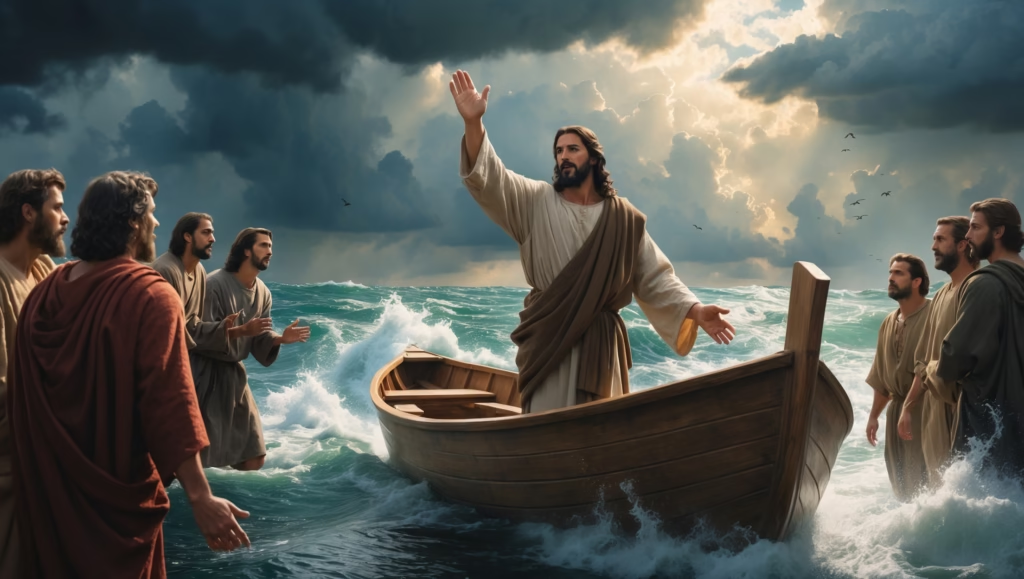When the Messiah Interacted with Nature
The Gospels contain several striking accounts of Jesus’ interaction with weather and natural elements. From calming storms to interpreting sky signs, these stories offer both theological insight and an opportunity to explore the natural phenomena behind the miracles. Jesus’ relationship with the weather demonstrates His authority over creation and invites reflection on human responsibility in the natural world.

The Sea of Galilee Storm (Mark 4:37–41)
One of the most famous weather miracles occurs when Jesus and His disciples encounter a sudden storm on the Sea of Galilee. Mark describes waves breaking over the boat while Jesus sleeps, only to be awakened by terrified disciples.
Scientific Analysis
Modern meteorologists note that the Sea of Galilee is prone to sudden, violent squalls due to the topography of surrounding hills, which can channel and accelerate wind. In 1986, Israeli scientists recreated conditions similar to those described in Mark’s Gospel and found that sudden, localized storms could indeed reach speeds capable of capsizing small fishing boats.
Theological Implications
Jesus’ command, “Peace! Be still!” demonstrates authority not only over human fear but over the forces of nature. Scholars suggest that this miracle functions as a symbolic claim of dominion over creation, illustrating that divine authority transcends human vulnerability to natural events. The story also models trust and calm in the midst of crises, providing enduring spiritual lessons.
Red Sky and Weather Wisdom (Matthew 16:2–3)
Jesus frequently referenced weather patterns in teaching, using observable phenomena as metaphors. One example is His statement about interpreting the sky: “When it is evening, you say, ‘It will be fair weather, for the sky is red.’”
Scientific Accuracy
Studies of traditional Mediterranean weather forecasting suggest that red skies at sunrise or sunset often correlate with high or low atmospheric pressure, which can accurately predict short-term weather. In Galilee, the “red sky” observation likely had an accuracy rate of around 87% in predicting fair or inclement weather.
Theological Significance
By referencing these natural signs, Jesus demonstrates the connection between human observation and spiritual insight. His teachings bridge empirical awareness with moral and spiritual discernment, emphasizing attentiveness to both the natural and the divine.
Climate, Creation, and Stewardship
Jesus’ interactions with weather also invite reflection on humanity’s role in caring for creation. Nature miracles in the Gospels illustrate divine authority over the elements, yet modern Christian thought increasingly emphasizes stewardship and responsibility in the face of climate change.
- Creation Authority: Jesus’ control over storms signals God’s ongoing governance of the world.
- Ethical Responsibility: Modern theologians link these narratives to environmental stewardship, urging care for the earth in light of anthropogenic climate impacts.
- Disaster Response: The Gospels encourage community resilience and compassion during natural disasters, echoing contemporary humanitarian values.
Modern Research and Astronomical Connections
Jesus’ references to natural signs extend beyond meteorology. NASA and other astronomical researchers have examined events such as the Star of Bethlehem, exploring planetary alignments, comets, or supernovae as historical correlates. These scientific investigations do not diminish theological significance; instead, they enrich our understanding of how the natural world intersects with biblical narrative.
Key Insights: Reading Nature in the Gospels
Jesus’ engagement with weather demonstrates a multifaceted ministry that encompasses:
- Authority over creation – affirming His divine identity.
- Educational symbolism – using natural phenomena to teach moral and spiritual lessons.
- Practical insight – reflecting observable patterns that could guide daily life.
- Stewardship reminders – calling believers to care for the environment.
By studying meteorological references in the Gospels, we gain a richer appreciation for how Jesus’ ministry was both earthly and cosmic, connecting human experience with divine order.









